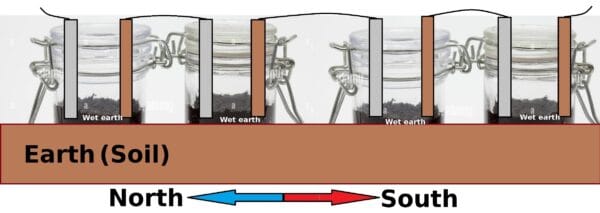In our quest for sustainable living, the notion of harnessing nature’s resources continues to inspire innovative projects. One such captivating idea is creating an Earth Battery – a simple yet effective way to generate electricity using everyday materials. In this blog post, I’ll walk you through how I built my DIY Earth Battery to power an LED stripe, bringing a unique light source right into my home.
What is an Earth Battery?
An Earth Battery is a type of electrochemical cell that generates electricity using soil as an electrolyte. By inserting copper and zinc electrodes into moist soil, you can create a rudimentary yet functional power source. While it may not replace conventional power sources, it offers an eco-friendly alternative for small-scale lighting solutions.
The Concept
My vision for this project involved using glass jars filled with dirt and water as the foundation for multiple earth batteries connected in series until I got around 12 Volts. The jars were constructed as follows:
Materials Needed:
– Glass jars with lids
– Copper rods (for the cathode)
– Zinc nails or rods (for the anode)
– Soil and water
– Connecting wires
– LED stripe (12V rated)
– Two different coloured conductive thin isolated cables*
*The different coloured cables are meant to better identify the plus and the minus poles of the two free electrodes from the first and the last jar, which are going to be connected accordingly to the LED stripe.
Step-by-Step Process
- Preparation of Jars: Start by filling each jar with a mixture of soil and water, maintaining a balance to ensure the soil remains moist without being oversaturated.
- Inserting Electrodes: Insert a copper rod and a zinc nail into one jar, repeat with each jar, ensuring they do not touch (scroll to the end of the article for a visual representation). These electrodes will create a voltage through electrolysis.
- Connecting Jars in Series: To achieve around 12 Volts, I will connect multiple jars in series (see representation at the and of this article). Each jar will contribute its energy, allowing us to power our LED stripe efficiently. Connect the copper electrode from one jar with the zinc electrode from within the next with conductive isolated wire and repeat the process with all the jars. At the end you will have a free copper electrode and a free zinc electrode, meaning the plus and the minus pole (from the first and the last jar) to connect the LED stripe.
- Sealing and Positioning: Seal the jars carefully to prevent evaporation (make sure you don’t damage the connecting wires which are exiting each jar), and bury them partially in the soil under a window. This will help maintain the necessary moisture.
- Alignment and Access: While somewhat experimental, aligning the jars toward the Earth’s north magnetic pole adds an intriguing element to the project. I’ll ensure the two free different coloured cables (from the first and last electrodes) run safely indoors, connecting the jars to the LED stripe.
Lighting Up with LEDs
Once the jars are properly set up, I connected the LED stripe, which served as a unique lighting source. The stripe will consist of about 30 LEDs, creating a cozy ambient glow that is especially welcomed during the evening hours.
Benefits of the DIY Earth Battery
- Eco-Friendly: Reduces reliance on traditional electrical sources, promoting sustainable energy use.
- Continuous Light Source: Provides illumination as long as the earth battery maintains its functionality.
- Aesthetic Appeal: The jars add a decorative touch to any space, blending nature and functionality.
- Educational Fun Experience: A hands-on way to learn about renewable energy and electrochemistry.
While this project is exciting, it’s not without its challenges. The voltage output from the earth battery may be limited, affecting the brightness of the LED stripe, adding one or two more jars (batteries) in series to achieve slightly above 12V, wouldn’t be a bad idea. Moreover, the corrosion of zinc electrodes over time means regular maintenance will be necessary to keep the system operational.
Creating a DIY Earth Battery is a rewarding project that combines innovation with sustainability. It offers a unique way to illuminate your space while engaging with the principles of renewable energy. I can’t wait to get started on my next earth battery and share my progress and findings with you all. Who knows? This might inspire you to embark on your own sustainable journey!
Stay tuned for more updates as I dive deeper into this project and share tips, successes, and any challenges I face along the way. Let’s light up our lives, one innovative idea at a time!
You could experiment with other metals too, for example Copper and Nickel, specially because no corrosion will take place, meaning less maintenance will be needed.

If you liked this experiment, make sure to explore my other science fiction articles, here!